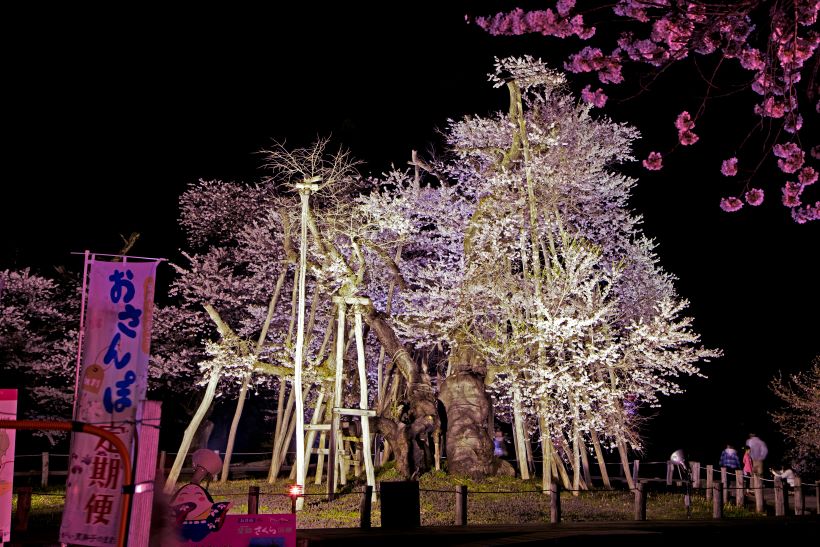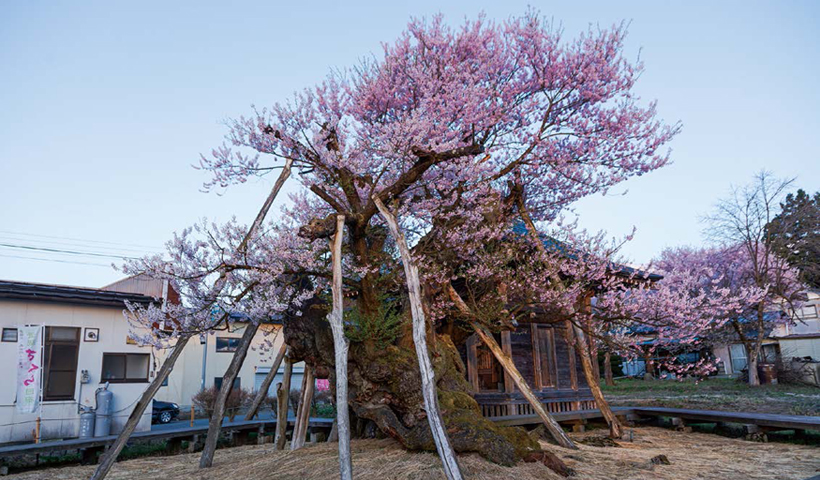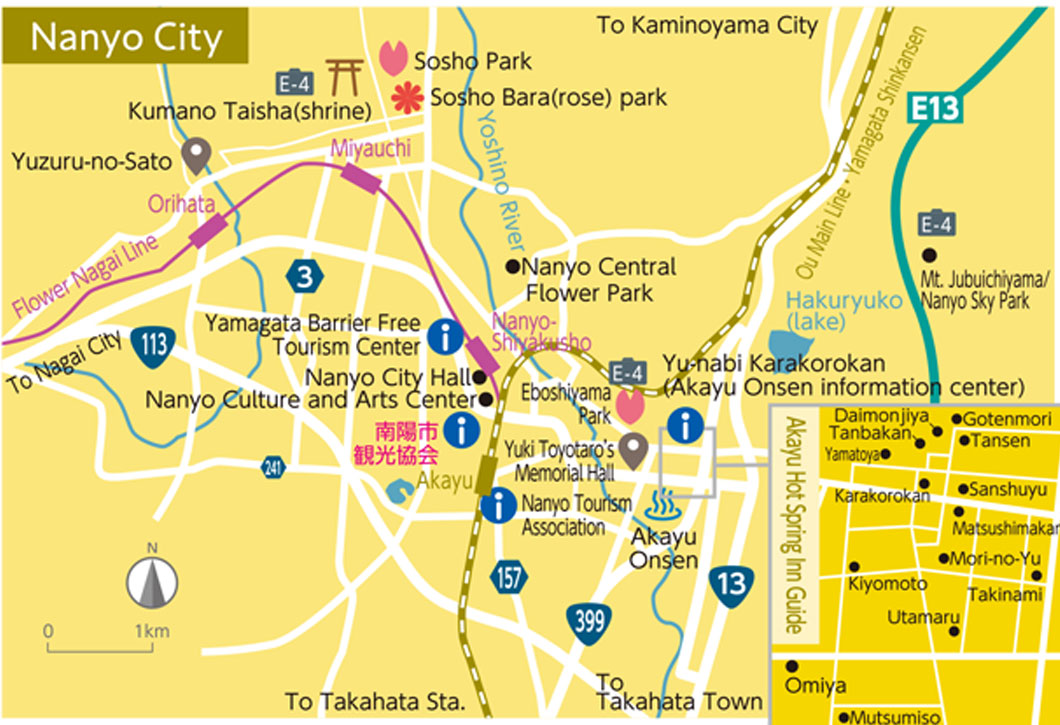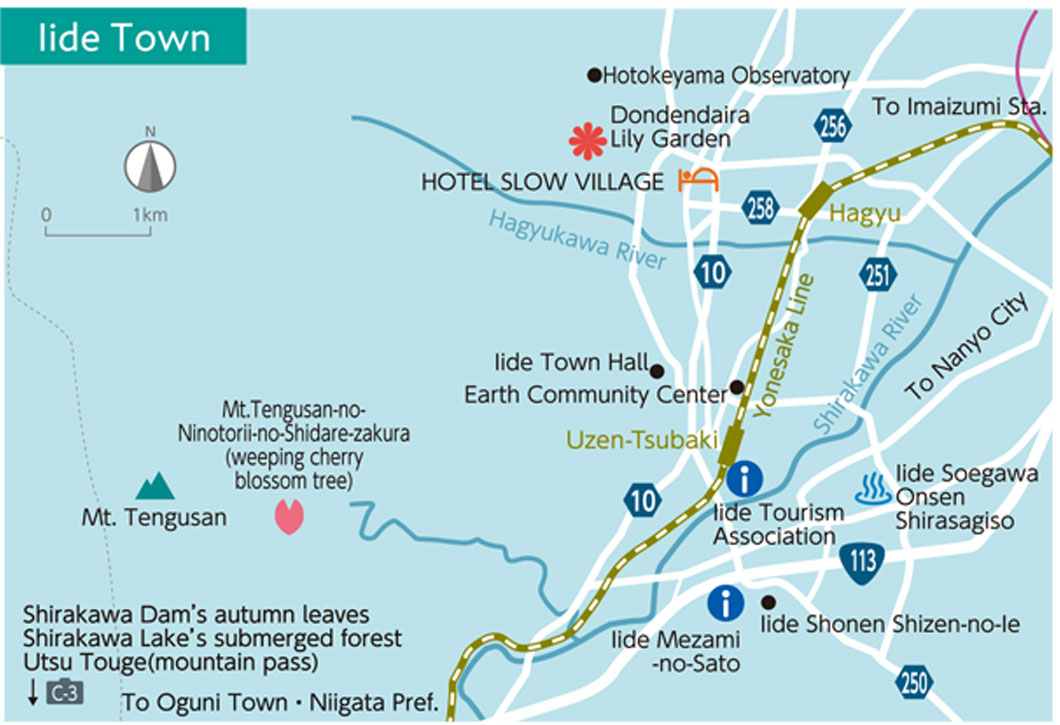
In the Okitama region where there are many famous cherry blossom (sakura) spots, there is a giant cherry tree said to be 1,200 years old. It has signaled to the locals of the oncoming of spring since the days of old. Sakanoue no Tamuramaro, who received the first title of Sei-i Taishogun, makes an appearance in the legend of the origins of the tree. The start of this beautiful cherry blossom begins with a hero and tragic love.
Plant Cherry Blossoms in Okitama,
An Extraordinary Hero
Sakanoue no Tamuramaro, a court nobleman of the early Heian period, is well known for being a loyal subject who served under the 4th emperor. He was especially skilled in fighting, open-minded, and comely. It is said, “his actions were agile and demeanor senseful. If angered, he would down a beast on the spot. When he laughed, children came to him.” There were many followers of Sakanoue no Tamuramaro in the lands he subjugated. So many it is said that they couldn’t supply horses to everyone who followed. He is known for erecting Kiyomizu-dera Temple in Kyoto, but there are other temples and shrines built for Tamuramaro. There are shrines that deify Tamuramaro country-wide. It’s clear how immensely popular he was, and it can even be said he was seen as a hero of sorts.
The first time someone was given the title Sei-i Taishogun was in the year 796 (Enryaku 16). Sometime then, he made two expeditions to settle Oshu. Five cherry blossom trees are said to have been planted by Tamuramaro in Okitama: Isazawa Kubo cherry blossom, Shirataka Ko-o Yakushi cherry blossom, and the three Kusaoka Daimyojin cherry blossoms. The Shirataka Miyama and Nagai City Kanjindai cherry blossoms have withered away.

Otama’s Tragic Love
“Isazawa Kubo cherry blossom”
When Tamuramaro came to this region, he stayed at the powerful Kubo clan’s house. He was engaged to Otama, the daughter of the powerful Kubo clan, but when his settlement of Oshu was completed, he gathered his army and left for Kyoto. Otama could not withstand her feelings of love, got sick, and passed away. Tamuramaro came back to Tohoku and found out about her passing. It is said with sorrow he took a cherry blossom from Mt. Maya in the Settsu province, and planted it with his own hands on her grave as a grave marker. As for the origin of the tree, there is a theory that the cherry blossom was sent there. There is another theory that a local member of a powerful clan mourning over the death of his wife named Otama and child planted the tree by hand. In each case, a woman named “Otama” makes an appearance, so that is why it is also known as “Otama cherry blossom.”

A Fantastic and Ephemeral Story
of Love and War
“Yakushi cherry blossom”
The story of Yakushi-do and the cherry blossom in Shirataka Ko-o is like a sequel to the legend of the Isazawa cherry blossom. Shrouded in grief from the loss of Otama, Tamuramaro made a flute by a pond’s edge and played it into the night. As if drawn by the timbre of the flute, a woman appeared. She stood in silence as he played the flute, and once finished, Tamuramaro’s damaged heart was healed. The two fell in love.
The woman’s house is on the bank of the swamp where she wants to build a nursery and have children. Tamuramaro was told, “I will give birth on the night of a full moon, and in half a month I will come back to you. Make sure no one comes to the nursery,” but he could not wait and headed to the nursery. There he saw a big, white snake coiled up fast asleep with a golden dagger. Tamuramaro, thinking that the snake ate the mother and child, became outraged, but he thought back on the mysterious events that happened after meeting the woman and gloomily left for home. A few days later the woman who visited Tamuramaro claimed she was the master of the swamp, and disappeared after giving birth to a golden sword made from valor.

One night, a woman came to him in his sleep and implored him to defeat a family of serpents who will attack her swamp in three days’ time. He heard her wishes and lobbed the leader of the serpents head off with the golden sword, but the village chief feared they were cursed. Tamuramaro pitied the death. He hand-planted one cherry blossom on a mound and built a temple. It is said the offering of the golden sword, and performed ritual are the origins of the tree.
The Connection to Date Masamune
“Kusaoka Daimyojin cherry blossom”
Regarding the origin, it is only reported that it was planted as a memorial when Tamuramaro conquered Oshu. There is a story that Date Masamune was defeated in the first battle of Ayukai in the 1580s, and survived by hiding himself in a cherry tree that had a hollowed-out hole big enough for one person. Masamune wrote, “桜子の 散り来る方を 頼み草 岡にて又も 花を咲かせん,” and sent it off with Yokoyama Kageyu, a retainer who carried it cordially. Even today, there are cherry blossoms on the site where the descendants live.
The Edohigan cherry tree has the longest life-span among cherry trees, because of its hard trunk and resistance to rot. However, some of them can’t bear the weight of the heavy snow and their thick trunks break. Still, their fervent ability to live a long life is noble. We can feel the long-awaited coming of spring through the old trees’ pale buds. Cherry trees bloom no matter the year as long as it is spring, and has a long history intertwined with humans so much so that they are almost legendary. Their existence has become a support for our hearts.






